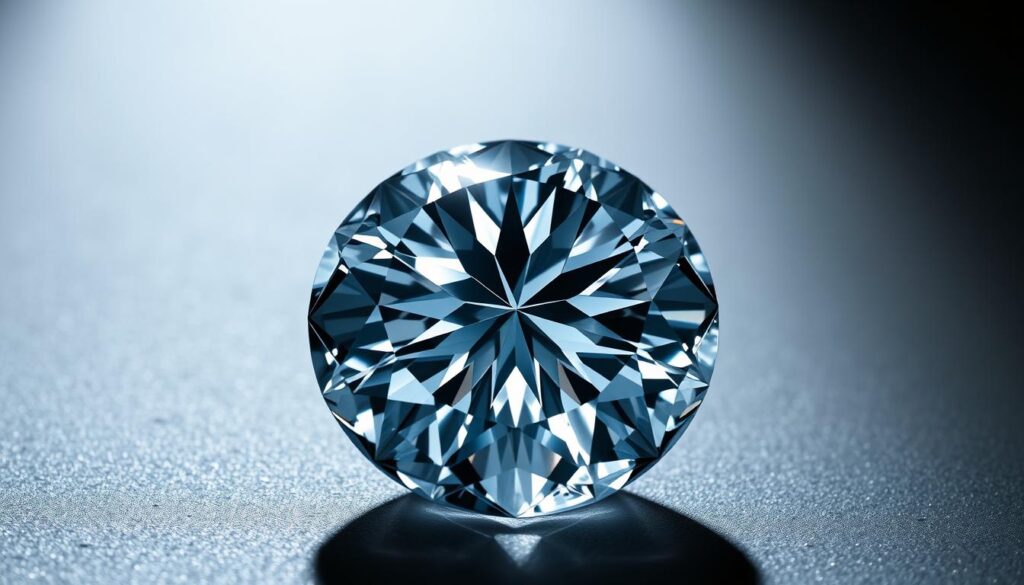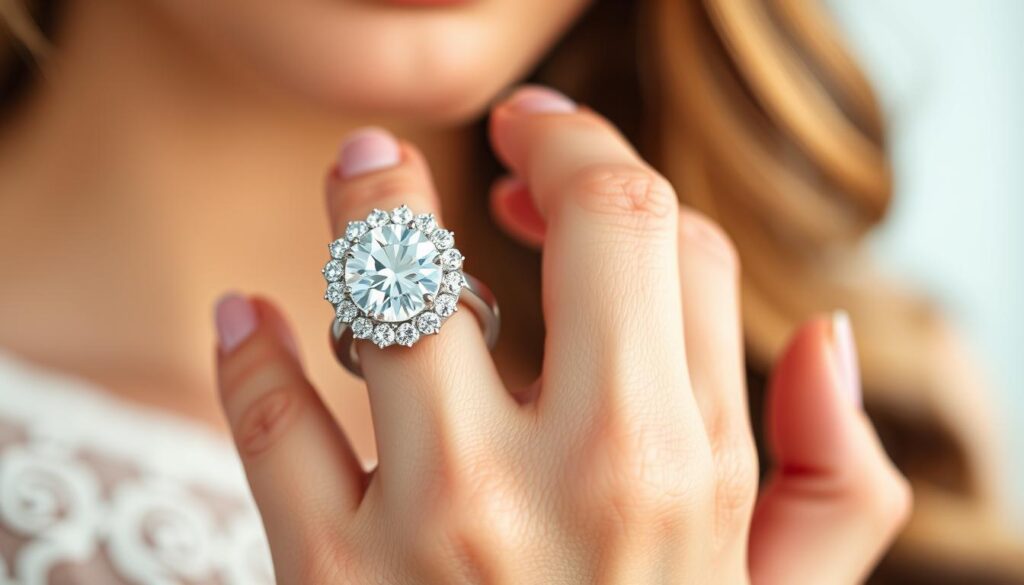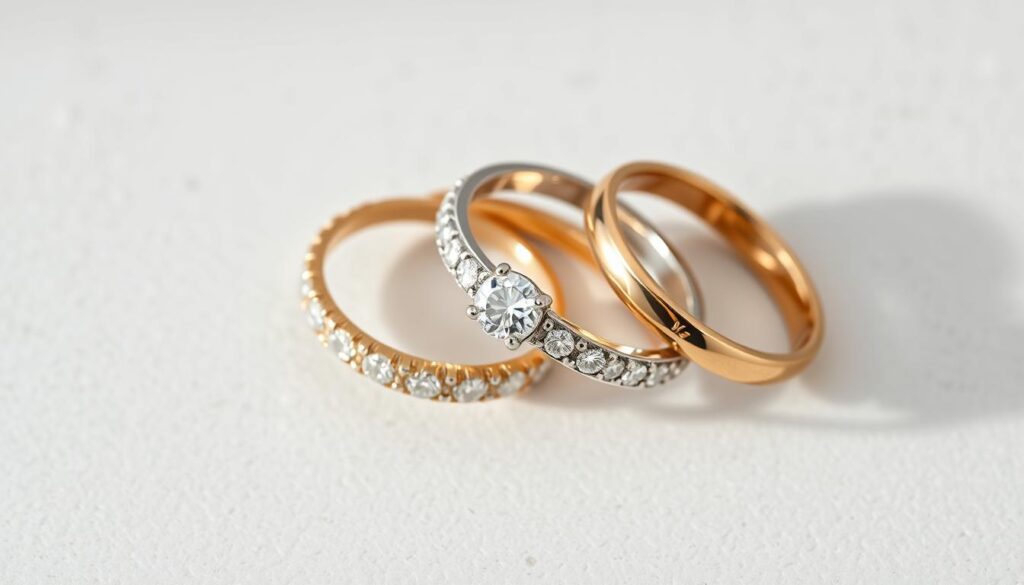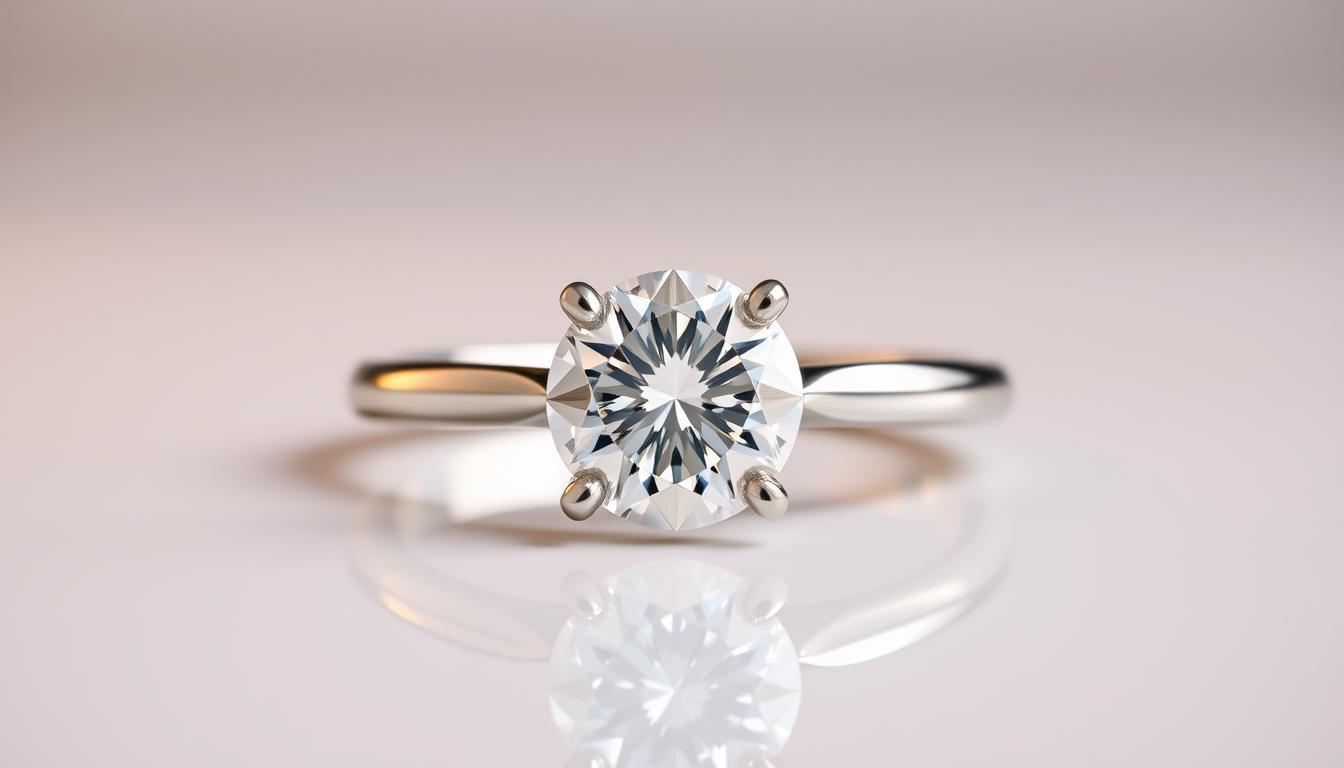Choosing the perfect engagement ring is a significant decision, both emotionally and financially. It’s a symbol of love and commitment that will be treasured for a lifetime.
Understanding the factors that determine the quality of a diamond is crucial. The 4Cs – cut, color, clarity, and carat – are essential in evaluating the value and beauty of a diamond ring. With so many options available, it’s essential to be informed to make the right choice.
Our expert guide will walk you through the process, providing you with the knowledge to select a ring that meets your expectations and budget, ensuring you find the perfect engagement ring for your special moment.
Understanding the 4Cs of Diamond Quality
The 4Cs of diamond quality are the foundation upon which the value and beauty of a diamond are determined. These four characteristics – cut, color, clarity, and carat weight – work together to define the overall quality and desirability of a diamond.
Diamond Cut: The Key to Brilliance
The cut of a diamond refers to its proportions, symmetry, and polish. A well-cut diamond refracts light better, appearing more brilliant and fiery. The cut is considered the most important factor in determining a diamond‘s beauty.

Color Grading: From Colorless to Light Yellow
Diamonds are graded on a color scale from D (colorless) to Z (light yellow or brown). The closer to colorless a diamond is, the rarer and more valuable it is. The color grade is determined by comparing the diamond to a master set of diamonds under controlled lighting conditions.
Clarity: Evaluating Internal Features
Clarity refers to the presence or absence of inclusions and blemishes in a diamond. Inclusions are internal features, while blemishes are external. The clarity grade is based on the number, size, and location of these imperfections. A diamond with fewer inclusions and blemishes is considered more valuable.
Carat Weight: Size and Value
Carat weight is a measure of a diamond‘s weight, not its size. While carat weight is closely related to size, the two are not the same. The price of a diamond increases exponentially with its carat weight, with significant jumps at certain weight thresholds, such as 0.50ct, 0.75ct, and 1.00ct. To get the best value, consider a diamond just below a popular carat weight, as the visual difference may be minimal, but the price difference can be substantial.
By understanding the 4Cs, buyers can make informed decisions when purchasing a diamond ring, ensuring they get a high-quality diamond that meets their needs and budget.
How to Buy Diamond Ring: A Step-by-Step Guide
The process of buying a diamond ring can be simplified by breaking it down into manageable steps.

Setting Your Budget Realistically
Before starting your search, it’s essential to set a realistic budget for your diamond ring. Consider your financial situation and decide on a comfortable price range. This will help you narrow down your options and make a more informed decision.
Prioritizing the 4Cs for Your Purchase
Understanding the 4Cs (cut, color, clarity, and carat) is crucial when buying a diamond ring. Prioritize the 4Cs based on your preferences and budget to find the perfect diamond. For instance, if you prefer a larger diamond, you may need to compromise on clarity.
Choosing Between Natural and Lab-Created Diamonds
You have the option to choose between natural and lab-created diamonds. Lab-created diamonds are more affordable and environmentally friendly, while natural diamonds offer unique characteristics. Consider your values and budget when making this decision.
When to Buy: Timing Your Purchase
Timing is everything when buying a diamond ring. Purchase your engagement ring at least 1-2 months before you propose to ensure timely delivery and any necessary adjustments. Consider seasonal factors, as many jewelers offer promotions during slower periods.
- The diamond ring buying process typically takes longer than expected, so starting early is advisable.
- Allow at least 4-6 weeks for the entire process, including comparison shopping and potential adjustments.
- Some jewelers may offer rush services, but these often come with premium prices.
- Consider seasonal factors in your timing—many jewelers offer promotions during slower periods or before major holidays.
- If you’re planning a proposal for a specific date, work backward from that date, allowing extra time for unexpected delays.
Selecting the Perfect Diamond Shape and Setting
Choosing the right diamond shape and setting can elevate your ring from beautiful to breathtaking. The shape and setting of your diamond can greatly impact its overall appearance and value.
Popular Diamond Shapes and Their Characteristics
Diamonds come in various shapes, each with its unique characteristics. The most popular shapes include round brilliant, princess, and cushion cuts.
Round Brilliant vs. Fancy Shapes
The round brilliant cut is the most popular due to its brilliance and fire. Fancy shapes, such as heart, pear, and marquise, offer a unique and distinctive look.
How Shape Affects Price and Appearance
The shape of your diamond can affect its price. Certain shapes, like the round brilliant, tend to be more expensive due to their popularity and the yield from the rough diamond.
Setting Styles That Enhance Your Diamond
The setting of your ring is crucial in showcasing your center diamond. Various setting styles can enhance the appearance of your diamond.
Prong Settings: Maximizing Brilliance
Prong settings are a classic choice, allowing maximum light to reach the diamond and enhancing its brilliance.
Bezel, Halo and Other Protective Settings
Bezel settings encircle the diamond with metal, providing protection and a modern look. A halo setting surrounds the center diamond with smaller diamonds, adding to its sparkle and making it appear larger.
Side Stones and Accent Diamonds
Side stones and accent diamonds can transform a simple solitaire into a more elaborate design. Popular choices include three-stone rings, adding a halo, or including diamonds along the shank of the ring.
- Side stones can significantly increase a ring’s total carat weight and value.
- Three-stone rings symbolize a couple’s past, present, and future together.
- When selecting side stones, their quality should complement the center diamond.
Choosing the Right Metal for Your Ring
The choice of metal for your diamond ring setting can either enhance or detract from the diamond’s natural beauty. The metal color of your ring setting plays a significant role in how your diamond appears, making it essential to choose a metal that complements your diamond.
Yellow Gold: Classic and Timeless
Yellow gold is a traditional and enduring choice for diamond rings. It adds a warm, vintage touch and can complement diamonds with lower color grades or those with distinct yellow or brown tints. Yellow gold settings tend to benefit diamonds with unique hues, making them appear more vibrant.
White Gold and Platinum: Modern Elegance
White gold and platinum are popular for their modern and sleek appearance. They are ideal for diamonds graded in the colorless to near-colorless ranges (D through J on the GIA color scale), as they highlight the diamond’s colorlessness. White metals like platinum and white gold make high-grade diamonds appear brighter and more brilliant.
Rose Gold: Romantic and Distinctive
Rose gold offers a romantic and distinctive look, adding a touch of femininity to diamond rings. It can make diamonds with slight yellow tints appear more colorless by providing a warm, contrasting background. Rose gold is a great choice for those looking for a unique and stylish setting.
How Metal Choice Affects Diamond Appearance
The metal you choose can significantly affect how your diamond looks. For instance, setting a colorless diamond in yellow prongs can give it a yellowish appearance, while white gold or platinum prongs can keep it looking colorless. Mixing metals, such as using white gold prongs with a yellow gold band, can optimize both diamond appearance and overall aesthetic. The reflective properties of different metals also influence how light interacts with your diamond.
- The metal color can dramatically influence how your diamond appears, either enhancing or detracting from its natural characteristics.
- White metals highlight the colorlessness of high-grade diamonds, making them appear brighter.
- Yellow and rose gold can make diamonds with slight yellow tints appear more colorless.
- The reflective properties of metals like platinum and gold alloys affect how light interacts with your diamond.

Ring Styles and Design Trends
Engagement rings come in a variety of styles and designs, each with its own unique characteristics and charm. The right style can make the ring even more special, reflecting the wearer’s personality and taste.
Classic Solitaire Designs
The classic solitaire design is a timeless choice, featuring a single diamond set in a simple band. This style is elegant and sophisticated, allowing the diamond to be the focal point. It’s a popular choice for those who prefer understated luxury.
Vintage and Antique-Inspired Rings
Vintage and antique-inspired rings offer a unique and romantic appeal. These designs often feature intricate details and ornate settings, giving the ring a distinct character. They are perfect for those who appreciate history and nostalgia in their jewelry.
Contemporary and Custom Designs
For those who want something truly unique, contemporary and custom designs offer endless possibilities. From unconventional settings to innovative uses of different materials, these rings are ideal for individuals who want their engagement ring to stand out.
Finding the Perfect Ring Size
Finding the correct ring size is crucial for comfort and to prevent the ring from being lost. Using a ring sizer is the most accurate method. For surprise proposals, guessing the size by borrowing a ring or using other creative methods can be helpful. It’s also important to note that ring size can fluctuate with temperature and time of day, so measuring at different times is advisable.
- Measure the ring size accurately to avoid resizing issues later.
- Consider that ring size can change due to various factors like temperature.
- For a surprise, enlist help from friends or family to guess the size.
Ensuring Your Diamond Purchase: Certification and Jeweler Selection
To make an informed purchase, understanding diamond certification and choosing the right jeweler are crucial. A diamond grading report from an independent laboratory like GIA ensures you know the identity and quality of your diamond, verifying whether it’s natural and if it has undergone any treatments.
When selecting a jeweler, look for expert training and credentials from recognized programs like GIA Graduate Gemologist or Applied Jewelry Professional diploma programs. An educated jeweler will explain the 4Cs of Diamond Quality, demonstrate differences between similar diamonds, and guide you in comparing diamonds within your budget.
Key considerations include:
- Ensuring diamond certification from respected laboratories for objective verification of a stone’s characteristics.
- Working with knowledgeable, ethical jewelers to transform the buying experience.
- Understanding different types of certifications and their standards to make informed comparisons.
- Proper insurance and maintenance to keep your diamond ring beautiful and protected.
- Reputable jewelers offering transparent policies on returns, resizing, warranties, and future upgrades.
Whether you’re choosing a classic solitaire engagement ring or a custom design with side stones, certification and jeweler expertise are equally important in ensuring quality and value. By focusing on these aspects, you can confidently purchase a diamond engagement ring that meets your expectations and budget.
Ultimately, a diamond engagement ring is a significant investment that requires careful consideration. With the right guidance and knowledge, you can find the perfect ring that shines brightly for generations to come.
